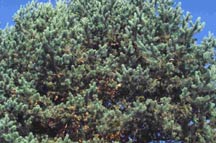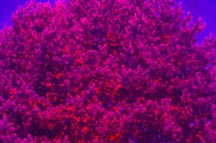|
BOB SIMONSON, Program Leader
SUMMARY EVALUATION OF STRESS DETECTION GLASSES Bob Monk, Project Leader |
||

San Dimas Technology
& Development Center
444 E Bonita Ave
San Dimas, CA 91773
(909) 599-1267
“Detect stress in your plants before it’s too late”. This is the type of statement used to market plant stress detection glasses. Do they work? How well do they work? Do they have applications in Forestry?
 |
The glasses are available through several commercial outlets. The glasses are marketed to producers of crops. They are advertised to spot, from a distance, stressed turf or field crops due to insect, disease or moisture stress. They would be an “early warning system” that can be used by field work crews. More recently they have been offered in forestry supply catalogues.
The glasses are designed to block the color green and enhance other colors. They would possibly amplify changes (reductions) of green in the plant foliage brought about by a change in the chlorophyll when the plant is under stress. The glasses could feasibly make it possible to detect color changes in green that would not be visible to the unaided eye. This would have application for determining when vegetation is under stress and providing advanced warning so that action can be taken to relieve that stress by watering, fertilizing, removing insects or disease, whatever is causing the stress. It may also provide application during designation of trees to be removed for salvage because of fire, disease or insect attack. It may be possible with the glasses to determine, at an earlier stage, when a tree is starting to fade. This could be very useful in the spring or early summer when trees start to come under moisture stress and fading of crown begins.
 |
 |
| Normal view of tree showing live and dead foliage. | View of same tree through stress detection glasses. Dead/dying foliage shows bright red. |
The glasses were tested at the San Dimas Technology and Development Center. The purpose of the testing was to determine if plant stress could be detected with the glasses before it could be detected with the unaided eye.
The value of the stress detection glasses appears to be in the way they amplify a person’s color perceptions. Determining what the observations mean will take some experience by comparisons with known plant stresses. Comparing different types of vegetation may be difficult. Changes in vegetation that is naturally a yellowish color may be difficult to detect. The glasses amplify color changes but give no indication of what is causing the change. As an example, natural color changes in leaves at the beginning of fall are significantly enhanced but the plant is probably healthy.
Some users find the glasses somewhat disorienting or upsetting. Others seem to have no problems, at least using them for short periods of time. The ability of the eye to detect plant stress problems seems to increase with experience. A novice may not notice minute changes that the seasoned veteran may think are obvious.
The glasses do appear to have utility for forestry work. Some experience with the glasses appears to help when evaluating what one sees. They may not provide magic answers as to whether vegetation is about to die but they do amplify a person’s perceptions. They are a relatively inexpensive, small, and lightweight tool. They can easily be carried to the field and can aid in quickly picking out vegetation changes.


